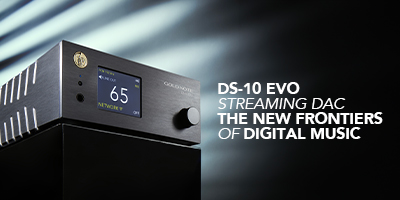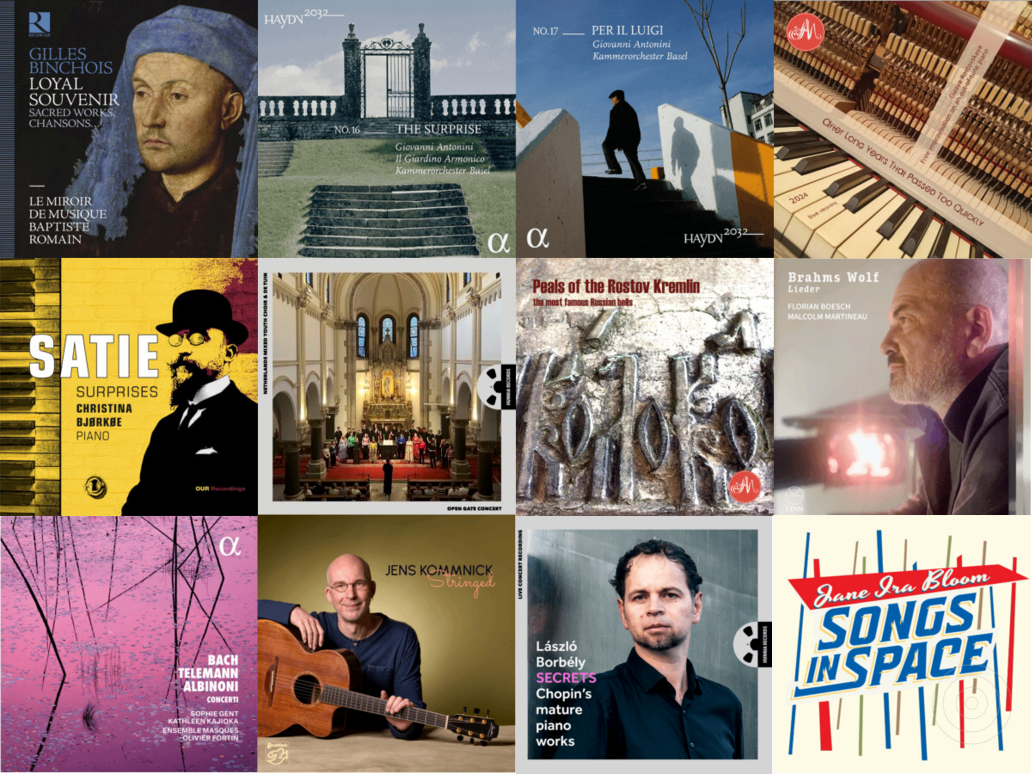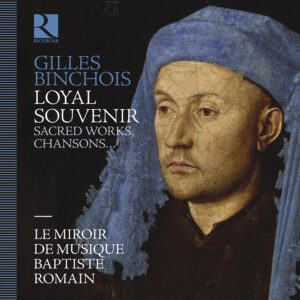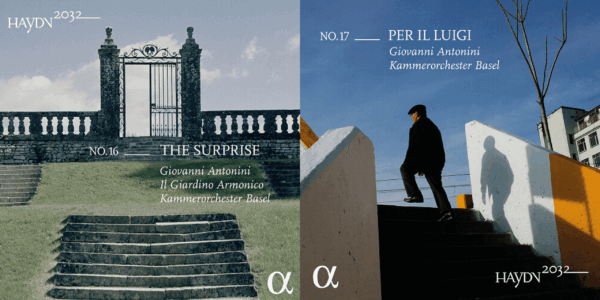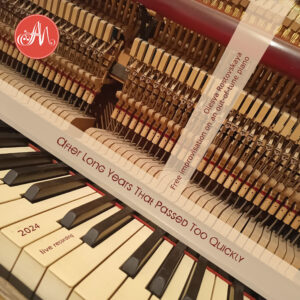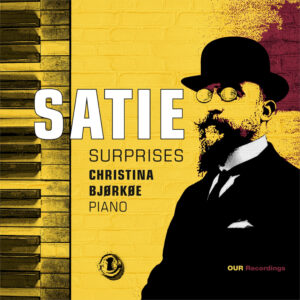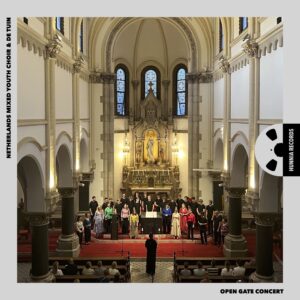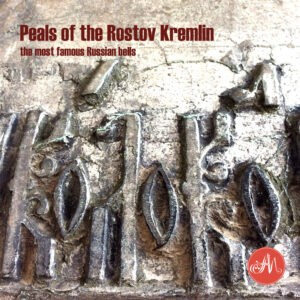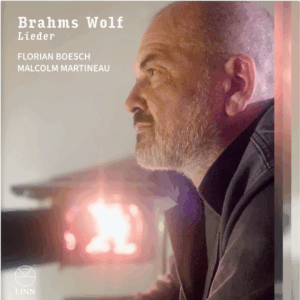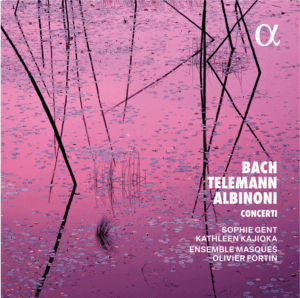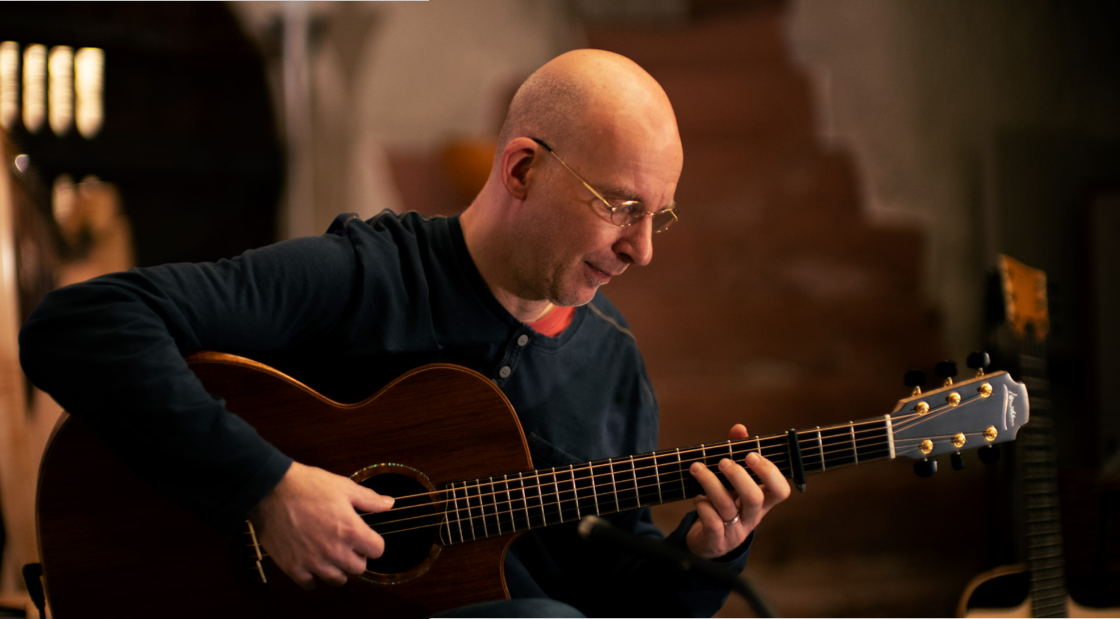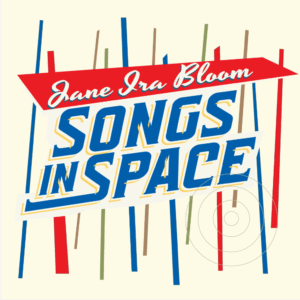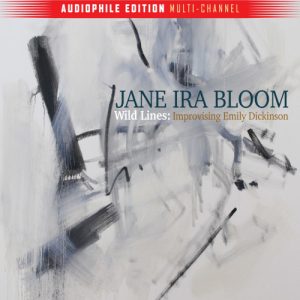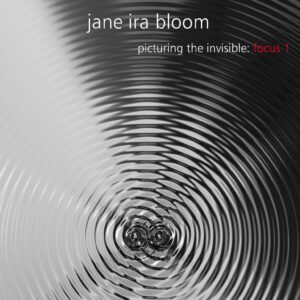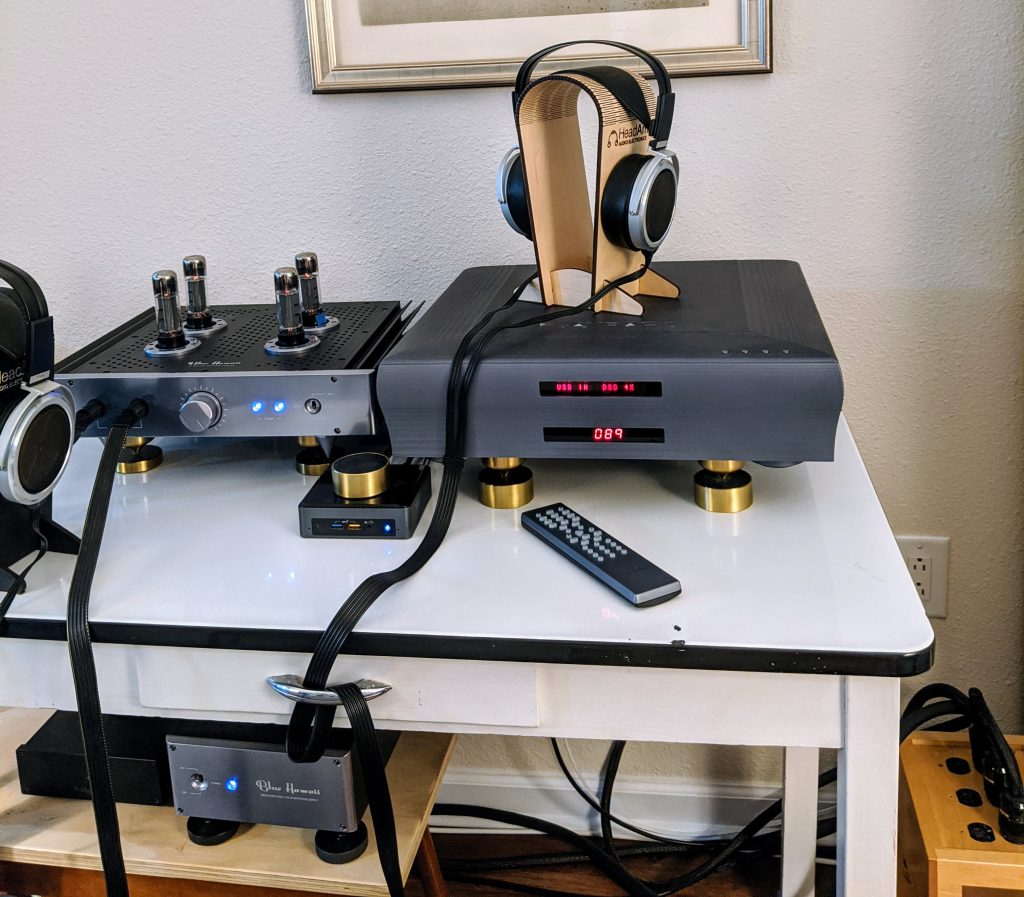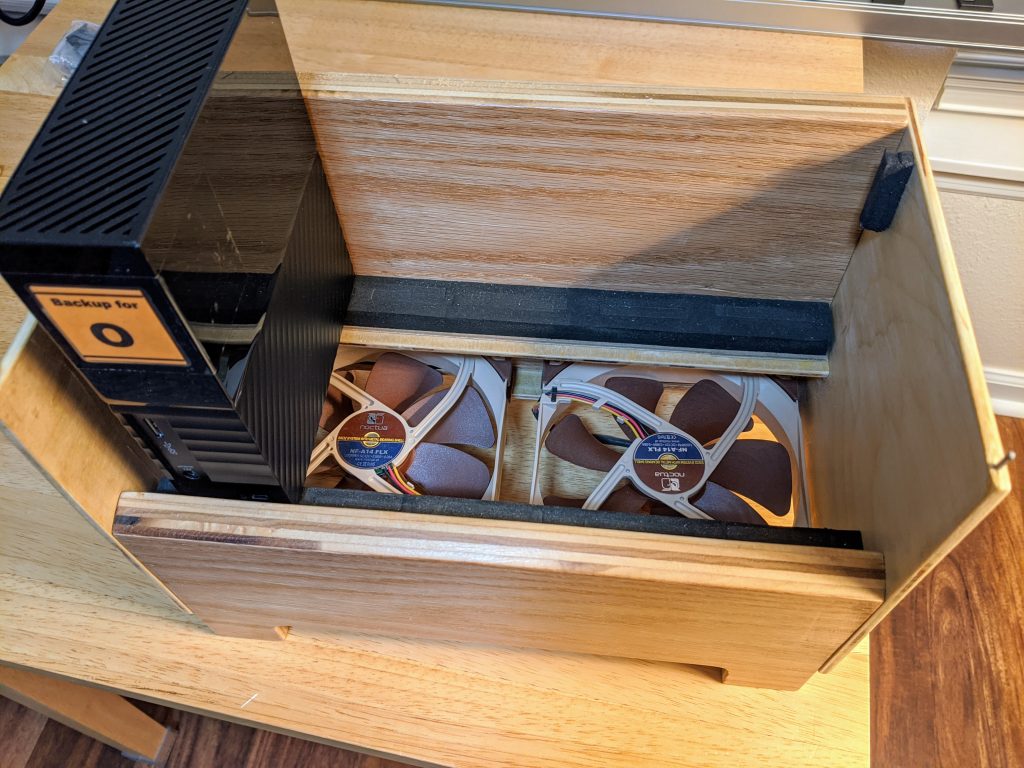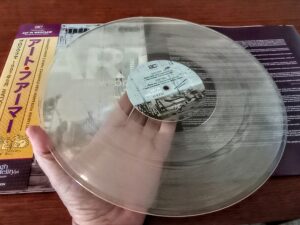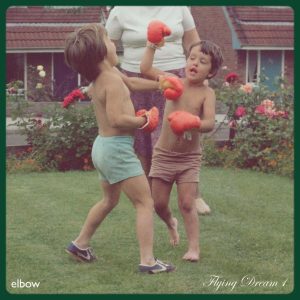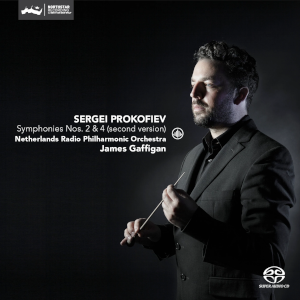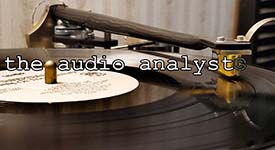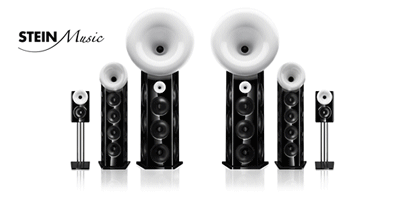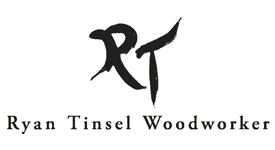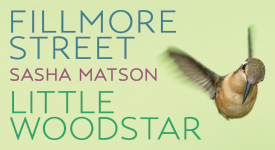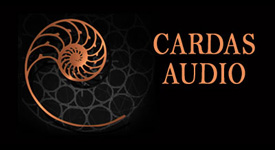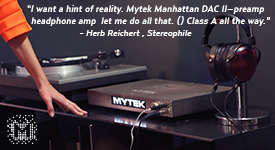This article of Recent Finds contains a truly disparate array of albums, but all of which I've enjoyed immensely. They are all beautifully recorded, supremely well performed, with interesting music that should be heard. I hope you will find something here that tickles your fancy. Mine has been tickled nearly to death listening to these.
Loyal Souvenir—music of Gilles Binchois, Le Miroir De Musique. Ricercar 2025 (192k*, Stereo). Edit Master Sourced HERE
Gilles Binchois (ca 1400-1460), was one of the most eminent composers of the early Renaissance. Highly esteemed by his contemporaries, Binchois is known most commonly through his polyphonic chansons and sacred works. In this album, Le Miroir De Musique shares with us a lovely selection of both his a cappella works (for voice alone, both men and women) and his works for voice with instrumental accompaniment. All of this is performed with period instruments and using historically informed performance practice. Instruments include slide trumpet, rebec, bombard, pipe, lute, gittern, gothic harp, gothic organ, vielle, viola d'arco, bagpipes, and chimes, with more I'm sure I've not listed. The variety of instruments used by the ensemble makes this an aural feast, and a very interesting one!
While without the legendary influence of Dunstaple, nor the stellar career of Du Fay, Binchois' compositions received a wide distribution as far away as Italy in the 1420s and 1430s, even though he never left the Burgundian Low Countries. That speaks volumes for his impact in his day.
The album is organized to shift from a cappella works to instrumental works to voice with instruments works, making the whole a continuing exploration of sounds, complexities, and polyphony. The program changes from secular to sacred and back. And with this constantly changing variety, it continues for nearly an hour and a quarter of interesting music performed at the highest order.
The included booklet contains an excellent essay by music director Baptiste Romain, who additionally plays vielle, rebec, and bagpipes. It is an education welcome to receive and read. Lyrics for the vocal works are included in French, German, and English translations.
If you do not have in your library already some music of the Renaissance, this is an album you should add to explore this genre. If you have a diverse collection of early music already, this is an album you should add—it will give you great pleasure. It certainly does for me.
Recorded in the église Saint-Léger, Leymen (France), April 2024, by Jérôme Lejeune. The cover illustration is not of Binchois—it is a painting by Jan van Eyck (1390-1441) titled simply Man in a Blue Cap (ca 1430).
For more suggestions for early music in excellent performances and sonics, I'll recommend to you an earlier article: Early Music from Medieval to Early Renaissance
Haydn 2032, No. 16 The Surprise, Complete Haydn Symphonies, Giovanni Antonini, Il Giardino Armonico, Kammerorchester Basel. Alpha Classics 2025 (192k*, Stereo). Edit Master Sourced HERE
Haydn 2032, No. 17 Per il Luigi, Complete Haydn Symphonies, Giovanni Antonini, Kammerorchester Basel. Alpha Classics 2025 (192k*, Stereo). Edit Master Sourced HERE
I will be the first to admit that the album titling mystified me, so lets make this a bit simpler... These are Volumes 16 & 17 of the planned complete cycle of the 107 Symphonies by Haydn. This massive effort is a collaboration between ensemble Il Giardino Armonico and Kammerorchester Basel (who will share performance duties) and Alpha Classics to celebrate the three hundredth anniversary of the birth of Haydn in 2032.
Volume No. 16 contains three symphonies (Nos. 90, 94 "Surprise," and 98, plus the six minute "Sinfonia" from Rossini's La Scala di Seta), with both Il Giardino Armonico and Kammerokester Basel performing.
Volume No. 17 contains three symphonies (Symphony No. 36 in E-Flat Major Hob. I:36, and Symphony No. 13 in D Major Hob. I:13, and Symphony No. 16 in B-Flat Major Hob. I:16) plus the Violin Concerto No. 1 in C Major Hob. VIIa, with Kammerorchester Basel performing.
The common thread among all of the volumes, the director is Giovanni Antonini, founding member of the Baroque ensemble 'Il Giardino Armonico', which he has led since 1989. As also principal guest conductor of Kammerorchester Basel, Antonini brings both groups into a similar performance style so there is admirable consistency across the volumes to which I have listened. I don't find any material discontinuity moving from one ensemble to the other, and in several of the volumes both ensembles are performing together.
Since this project has been running already for several years, there are differences in recording venues, and the recording engineer/producer has changed at least once. The differences in the sound of the varying recording venues and recording team is noticeable, but no more bothersome than if one were attending live performances in different halls. All of the volumes I've listened to (six, now) are nicely recorded with good balance and detail. The more recent Volumes 16 and 17 even more so than the earlier.
These performances are distinctly characterful to my ear. It is perhaps because Maestro Antonini has made a very conscious decision to allow the notes to speak "like someone who has to give a speech, even a terse or rapid one, while ensuring the intelligibility of each individual word." Rather than play the notes as fast as possible, as in some performances, especially on modern instruments, that play "at high speed, which produces an effect of sparkling brilliance," Antonini slows things down a bit. This may sound too slow to some who listen only to modern instrument recordings. But, to one familiar with 18th Century practice, the slightly slower pace allows for greater discourse to occur. "Articulation and rhythmic inegalité are also fundamental elements of the performance practice of eighteenth-century music." Too play too fast loses this discursive ability so characteristic in 18th Century performance practice, and which provides such character and individuality to performances.
I recommend any and all of these to you. The performances are alert, expertly played, and nicely recorded. If you enjoy Haydn's symphonies, and you enjoy historically informed practice and historic instruments, you will enjoy these recordings. I certainly am!
Belatedly, I have found an explanation for how these volumes are arranged, one of the booklets tells us: "Giovanni Antonini has decided to tackle the symphonies not in chronological order, but in thematically based programmes ('La passione', 'Il filosofo', 'Il distratto', etc.). Moreover, the Italian conductor believes it is important to establish links between these works and pieces written by other composers contemporary with Haydn or in some way connected with him. Hence, alongside his symphonies, the volumes will include music by figures like Gluck, W. F. Bach, Mozart, Cimarosa and Kraus." So, there you have it.
After Long Years That Passed Too Quickly, Olesya Rostovskaya. Artes Mirabiles 2025 (DXD 32bit, Stereo, MCh). Edit Master Sourced HERE
Can an improvisational solo piano recording, played on a piano that has been neglected for years and out of tune, be a worthwhile listening experience? In this case, yes! Definitely, yes.
I nearly passed by this recording after reading the album description. After 40-years, pianist/composer Olesya Rostovskaya reacquired the piano she was drawn to in her childhood, before she could even walk. It is her very first piano and used in the first years of her musical training. Forty years had gone by since her family gave away this piano and acquired a new one. But this old piano reappeared in her life, and she reacquired it, dusty, out of tune, neglected, but still playable. She chose not to restore it or even tune it—there were too many memories associated.
Instead, she uses this piano in its neglected state for a very emotional, deeply compelling journey with her own compositions. They could exist only with this piano, in this state. The recording contains no splices or processing and features only a live performance of five improvisational suites. It is remarkable. And remarkably compelling.
The album is very appropriately sub-titled "Free Improvisations on an out-of-tune piano." And I warmly recommend it to you.
Satie Surprises, Christina Bjørkøe. OUR Recordings 2025 (96k*, Stereo). Edit Master Sourced HERE
Keep it short. The poet Jean Cocteau's description of the composer: "The smallest work by Satie is small in the way a keyhole is small. Everything changes when you put your eye to it."
This is such an apt quotation from the liner notes. Erik Satie (1866-1925) dealt in miniatures, but miniatures of such pithy insight, and sparkling wit, that his compositions consistently intrigue and delight me. Perhaps they do you, as well. If you don't know Satie, you should spend some time with him. Your life will be richer for it.
Most of his works are originally for piano. And I came to know them through the marvelous performances of Aldo Ciccolini on various EMI LPs which I have no longer. So, I was pleased to find these performances by Danish pianist Christina Bjørkøe (b. 1970). Bjørkøe gives us excellent performances of these delightful snippets, some as short at 44-seconds, none longer than a little over 4-minutes. In many respects, her performances are more well-judged and avoid many of Ciccolini's own eccentricities and somewhat drier playing (based on my recollection only, not a direct comparison). The sound quality here is likely better as well.
Satie's influence was once barely known. Today it seems to have seeped into every facet of life. The experimental composer John Cage famously called Satie "indispensable," citing him as a profound inspiration for his own work.
Satie was irreverent. His eccentricities were part of his charm. And this whimsy seeped into his work with regularity with works given absurd titles like Effronterie (heard here on track 3) and Prélude canin (track 16), gleefully written to deflate the precious seriousness of classical music tradition.
This album is an engaging collection of somewhat less familiar Satie piano pieces, and it a welcome reminder that there is much to explore beyond the popular Gymnopédies and Gnossiennes.
Recorded January 2025 at Danish National Academy of Music. Odense, Denmark, and performed on a Steinway & Sons Model D Grand Piano, the recording is benefited by a rich, rounded sound in a warm acoustic. Yes, it's original recording resolution is only 96kHz (something I wish recording engineers would move beyond), but NativeDSD's Higher Rates Program bequeaths us alternative higher resolutions that may benefit your DAC's resolving capabilities.
Colin Drake, in his review for Fanfare (US), concludes "This is some of the best Satie playing I have ever heard, beautifully recorded, illustrated, and annotated" (HERE). I am very happy to go with that.
Open Gate Concert, De TUIN, Irene Verburg, Nemes László Norbert, Netherlands Mixed Youth Choir. Hunnia Records 2025 (Pure DSD256, Stereo). Edit Master Sourced (HERE)
If you love good choral music programs, here is a delightful album for you to consider. The voices are mixed choirs of aspiring younger artists supported by Vocal Talent Nederland, the foundation that organizes the National Children's Choir, the National Boys Choir, the National Mixed Youth Choir, and the National Women's Youth Choir. This recording is of a live performance in the Jesuit Church of the Sacred Heart of Jesus, Budapest, that took place on July, 25 2024.
The music is diverse, from Hildegard von Bingen, to traditional Armenian, Dutch, Finnish, and Swedish songs, to Bartok, to a modern French chanson made famous by Edith Piaf, to Lennon/McCartney's Blackbird.
What I find remarkable about this recording, and enjoy so much, is its utter clarity. The Pure DSD256 recording shines in capturing this level of detail while sounding supremely natural and well-balanced in this nicely reverberant performance space. The timbre of the voices is presented beautifully, with individual voices clearly differentiated.
I could listen to this again and again just to luxuriate in the transparent sound quality. That it additionally is so beautifully sung and well programmed is a bonus hard to beat. Hunnia's recording engineer, Sándor Árok, has done remarkable work capturing this live performance so attractively and convincingly. It is a live performance, so there is respectful applause in between each work, but the audience is remarkably quiet during each song.
Very nicely done all around.
Peals of the Rostov Kremlin: The Most Famous Russian Bells. Artes Mirabiles 2025 (Pure DSD256, Stereo, MCh, Immersive). Edit Master Sourced HERE
This is a recording of the great bells on top Cathedral Bell Tower, Rostov Kremlin, in Moscow, containing the complete set of ancient bells, weighing from 32 tons, to 16 tons, to 8 tons, and then smaller. After the revolution of 1917 bell-ringing was prohibited throughout Russia and the bells of the Cathedral Bell Tower would not be heard again for more than four decades until the early 1960s. Even then, ringing at the Cathedral bell tower was only allowed by exception and regular bell-ringing did not resume until 1987 at the time of "perestroika."
In 2017 a group of bell-ringers was formed to study the music score transcriptions and examine recordings made in 1963 of bell-ringers who could still recall the old tradition. They studied the actual bells, their acoustics and the systems used to control them. The idea was to record the bell tower like a symphony orchestra using a high definition audio recording equipment and 23 microphones with frequency range from 2Hz to 50kHz. No claim is made that the frequency extremes are actually captured in this Pure DSD256 recording, but the sound we can hear is most impressively realistic.
If you have never heard massive bells such as these, this recording may be a revelation to you. The timbre and unique tonal quality of each of the different bells is captured beautifully. This is not at all like the experience one may get in hearing a recital on a campanile, this is a vastly more sonorous, deeper, and resonate sound that is rare to experience.
Photos courtesy of Artes Mirabiles
Brahms and Wolf Liede, Florian Boesch, Malcolm Martineau. Linn Records 2025 (192k*, Stereo). Edit Master Sourced HERE
If you are at all open to lieder, then this new release from Linn Records should be on your radar for listening. Florian Boesch is a marvelous baritone—very expressive, great control, excellent range. Pianist Malcolm Martineau is masterful in his accompaniment. Together, they make an excellent duo.
And the music is some of the best in the literature of song. They contrast songs from Johannes Brahms and Hugo Wolf, two geniuses who hated each other. But who, between them, wrote some of the most compelling songs which express deep emotion and philosophical themes.
Brahms's Vier ernste Gesänge, written in memory of Clara Schumann, contrasts melancholy with transcendence, while lieder like Sehnsucht and Die Trauernde evoke poignant pain and unresolved longing.
Wolf, in his Goethe and Michelangelo songs, captures profound existential reflections, contrasting fame with love and weaving harmonies that echo the complexities of human emotion. The album concludes with Wolf's Prometheus, a tour-de-force of maximum power befitting Florian and Malcolm, two giants of the lieder scene.
I've never been a fan of vocal music. It just never attracted me for listening. But times change, and thankfully so have I, because I enjoyed this recital immensely. I found Boesch and Martineau intensely compelling, consistently engaging. I don't understand German, not a word of it. But the expressive delivery by Florian Boesch made understanding the words unnecessary. The content for me was in the delivery: the elegance of tone, the poignant pauses, the subtle variations of voice, and delicious changes in volume. All of it spoke to me. All of it I enjoyed very much.
For those who care about such things as lyrics, a complete translation in German and English is provided in the enclosed booklet. Some day I may actually read the lyrics and then gain a deeper appreciation, but skating on the surface is still an immense pleasure.
Austrian baritone Florian Boesch is counted as one of today's foremost lieder interpreters with appearances in all major concert halls in Europe as well as throughout the USA and Canada. Boesch was an artist-in-residence at Wigmore Hall, Konzerthaus in Vienna, Teatro de la Zarzuela in Madrid, Theater an der Wien and Elbphilharmonie in Hamburg.
Recognized at the highest international level as one of the UK's leading song pianists, Malcolm Martineau has performed worldwide alongside the world's greatest singers including Sir Thomas Allen, Dame Janet Baker, Florian Boesch, Elīna Garanča, Sir Bryn Terfel, Susan Graham, Thomas Hampson, Sir Simon Keenlyside, Angelika Kirchschlager, Dame Felicity Lott, Anne Sofie von Otter and Sonya Yoncheva.
Bach, Telemann, and Albinoni: Concerti, Ensemble Masques. Alpha Classics 2025 (192k*, Stereo). Edit Master Sourced HERE
There is some very stylish playing going on here, and I very much like what I hear. The Ensemble Masque, directed by Olivier Fortin from the harpsichord, plays with great technical proficiency, but never mechanically. They are alert, engaging, and joyously playful. And, still, in the slow passages, they can milk the emotional depths with the best of them.
On one album we have some of the outstanding concertos by three gods of the Baroque: J.S. Bach, Georg Telemann, and Tomaso Albinoni. An afternoon's listening just doesn't get much better than this music so beautifully performed. My, how the standards for excellence have been raised over the decades with this recording demonstrating the way of it.
Soloists Sophie Gent (violin) and Kathleen Kajioka (viola) give masterful performances in their respective concertos. As Kajioka comments, "It is quite seldom that the viola plays as a soloist, and above all in the 18th century, when its rather unspectacular role was almost always that of an internal voice at the centre of an ensemble. The fact that Telemann here places it at the forefront and handles it in a very carefully worked-out way, is something quite remarkable." And her performance is equally quite remarkable and enjoyable.
The two Bach concerti are equally well performed by Sophie Gent, who says of them: "They are exceptionally well written for the violin: the very model of baroque repertoire for the instrument, a perfect combination of instrumental virtuosity and profoundly beautiful musical expression, and an inexhaustible source of inspiration." She plays in a very straight-forward manner, without artifice, which I greatly value. She is allowing Bach to speak, not placing the performer ahead of the composer but always playing in service to the music. Bravo.
The Albinoni works are the bridge—without any soloist, they bridge the violin sonatas of Bach and the viola sonata of his contemporary Telemann. They present a sinfonie in five parts, requiring all the musicians of our ensemble performing in ensemble. And they are perfectly balanced between the upper and bass registers, thus presenting numerous possibilities of 'playing' across those registers as in the sense of a game. Every melodic line is busy, every orchestral part actively engaged. Each part plays off the other with two violins, viola and bass, with the bass line carried between the harpsichord, cello and double bass. These truly are magnificent works.
The sound quality is very good, as we've come to expect of Alpha Classics. Recording and mastering engineer Aline Blondiau does a wonderful job of balancing the soloists and ensemble and capturing a very nice balance of direct and reflect sound. Inner detail is delightful, but not at the cost of feeling that a microphone has been jammed down the throats of the instruments (with minor exception on the Telemann). As an Edit Master Sourced release, NativeDSD is able to give us all the various resolutions up to DSD512. I am listening to the 192k iteration in which the album was originally recording and which I think is also the edit master. On my primary system, this sounded best when I compared, but your results may certainly vary from mine depending on your DAC.
Highly recommended!
Secrets: Chopin's Mature Piano Works, László Borbély. Hunnia Records 2025 (Pure DSD256, Stereo). Edit Master Sourced HERE
If you seen earlier articles from me, you've likely encountered by recommendations for other recordings by Hungarian pianist László Borbély. I've come to like his playing very much. And this is the first venture into Chopin that I'm aware of. Here he brings the same strengths for which I enjoy his recitals: great technical proficiency, singing lines filled with emotion and energy, drama in his tempo and volume shifts, a deep intellectual understanding of what he's about, and a strong, somewhat muscular style in his playing. This is not the Russian approach to Chopin—it is more nuanced, more subtle. It is more in line with the central European style of play, with emotion but not grandiosity.
The magic of Chopin's music for me is that it supports many interpretive approaches, many different styles of play, but the voice of Chopin comes out clearly in the music (most times—it is possible to lose the thread). Borbély decidedly does not lose the thread. He's in it all the way, and while doing so he is unveiling aspects of the music that occasionally go missing with other pianists.
There are many pianists whose recordings of Chopin I adore, and Borbély's efforts here are fully competitive, fully enjoyable. Moreover, the works that Borbély has selected to play in this recital are among Chopin's most interesting and engaging music.
As Borbély describes in the liner notes, Chopin is a complex ambivalent creature. On the one hand, he is completely aware and respectful of traditions (especially Bach and Mozart), but he rebels. He wants nothing more than to defy musical public opinion, to challenge convention. And yet his music always strives for harmony. He fights for it again and again in his compositions. Chopin "simultaneously seeks to be still and yet still in motion. With him, nothing is ever "ready"... his art is itself a mapping of the limits, of instability."
And I love performances that are able to capture this contrary aspect of Chopin, as do these.
Borbély goes on to explain that Chopin's works are always imbued with an improvisatory spirit, "a desire to celebrate the moment. Chopin must therefore never be performed with an academic style..." So, again, this is an aspect of how Borbély approaches these works that simply suits my tastes to a "T". In his playing, one never quite knows how a lingering note, a pause after an unfinished phrase, will resolve. And this is the power of Chopin's music when played so well as in these performances.
And, in a big plus, the sound quality of the recording is excellent: excellent balance of direct and reflected sound, and beautiful capture of the timbre of the instrument, and full unrestricted dynamic range. It is recorded in a studio and not a concert hall, unfortunately, but Hunnia's recording engineer Sándor Árok has done some excellent work compensating. Captured in Pure DSD256-Analog Mixed** before a live audience, this recording places one right with fellow members of the audience. Superb! You will not be disappointed.
Stringed, Jens Kommnick. Stockfisch Records 2025 (88.2k*, Stereo). Edit Master Sourced HERE
German multi-instrumentalist Jens Kommnick has an unmistakable style on the guitar, somewhere between Celtic Fingerstyle Guitar, Classical, Jazz and Folk. Somewhat reminiscent of U.K. guitarist Martin Simpson, but definitely his own unique style. His instruments are all strings, from the warm and brilliant sound of his guitar that simply stops you in your tracks, to the variety of strings with which he accompanies himself playing guitars, bouzouki, mandolin, cello, fretless bass, piano, and harpsichord.
This is a gentle jazz-Celtic-folk combination brilliantly constructed to utterly enchant and delight.
Kommnick says this is his fourth solo album, his third was released in 2015. After hearing this, I must seek out all of them.
Stockfisch Records is one of those special labels whose sound quality is always superb. Most of their output is studio recorded, much of it is very "folk" flavored. Almost all of it I enjoy very much. You can see a reasonably large sampling of their catalog, recent releases, at NativeDSD, HERE. I we could only get them to switch to recording in DSD256 rather than mid-res PCM, life would be more grand. At least this is "Edit Master Sourced" so the sound quality is utterly clean and clear, with additional resolutions up to DSD512 available through NativeDSD's Higher Rates Program. I'm listening to the 88.2k edit master, ymmv.
Jens Kommnick, from the enclosed booklet courtesy of Stockfisch Records 2025
Jane Ira Bloom, Songs In Space. Anderson Audio New York 2025 (DXD 32bit*, Stereo, MCh, Immersive). Edit Master Sourced HERE
Jane Ira Bloom is a very special artist. She has worked in jazz for over 45 years, and for a good twenty years she has been one of the elite soprano saxophonists of modern jazz. If you've not heard her other albums, you really should go find them. If you don't know Jane Ira Bloom, get acquainted through her bio (HERE).
In this album, Bloom returned to the studio to record live for three days in high-definition Stereo, 5.1 Channel Surround Sound and 5.1.4 Channel Immersive Sound at the Clive Davis Institute in Brooklyn, NY with her Grammy award team of Jim Anderson and Ulrike Schwarz, two magicians of the studio engineering space. If you have the ability to play surround or immersive, you really need to hear this album. I listen only in stereo and I find the album simply stunning. In surround or immersive it has to be an entire new universe of sound experience.
Bloom is magical on soprano sax—her sound has long been one of the richest, uniquely identifiable sounds of any artist on their respective instrument. And her defining sound is gloriously captured in this album. And the interplay with Dominic Fallaco (piano), Mark Helias (bass) and Bobby Previte (drums) makes for an extremely polished, highly innovative, musical experience. Together they perform one shy of a dozen selections of highly polished gems, each a concentrated, deliciously succulent, miniature masterpiece.
Jim Anderson and Ulrike Schwarz are full active partners in creating the experience. There are sound experiments going on throughout this album that could almost make me a believer in highly processed studio sound. The experience is entirely different than a live acoustic performance, my sine qua non for music enjoyment. But I am enjoying the heck out of this new album from Bloom, as I have each of her other albums.
This is a must have album for anyone who appreciates modern jazz. A tremendous addition to her collection of recordings, two of which are additionally "must haves":
Jane Ira Bloom, Wild Lines - Improvising on Emily Dickinson. Anderson Audio 2017, Audiophile Edition 2020 (DXD, Stereo, MCh). Edit Master Sourced Review
Jane Ira Bloom, Picturing The Invisible: Focus 1. Anderson Audio 2022 (DXD, Stereo, MCh, Immersive). Edit Master Sourced, Not Reviewed, Album HERE
* 192k (or 96k or 88.2k in some cases) is the original recording resolution, but since this album is Edit Master Sourced, NativeDSD additionally offers this album in DXD and in all DSD resolutions up to DSD512 through their Higher Rates Program. Depending on your DAC, you may get better audio results with one of these higher resolution files (see Choosing the Best Sounding File Format). Now, if only Outhere Music would start expecting its recording engineers to originally record in DXD or DSD256 for the greater initial sonic density... (hint... hint...).
** Pure DSD256-Analog Mixed. This is one of two categories of Pure DSD256 recordings described in greater detail in the recent article, Get the Master Tape Listening Experience with Pure DSD256.

